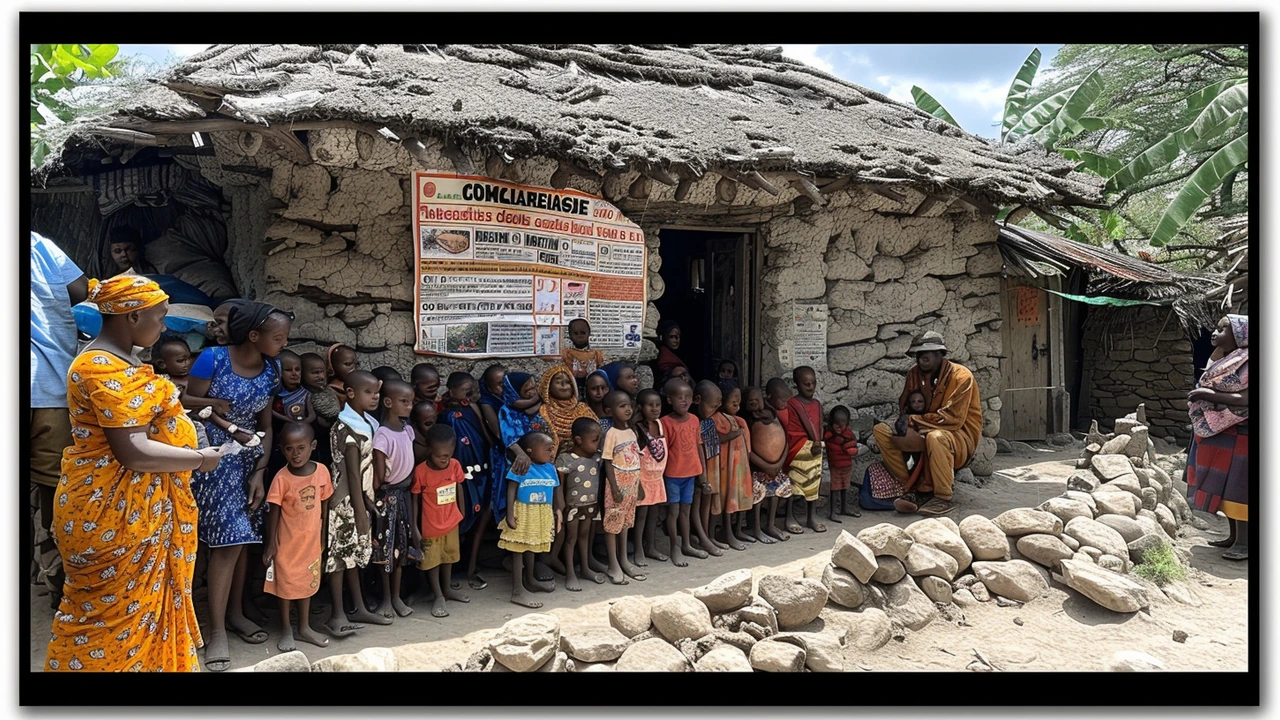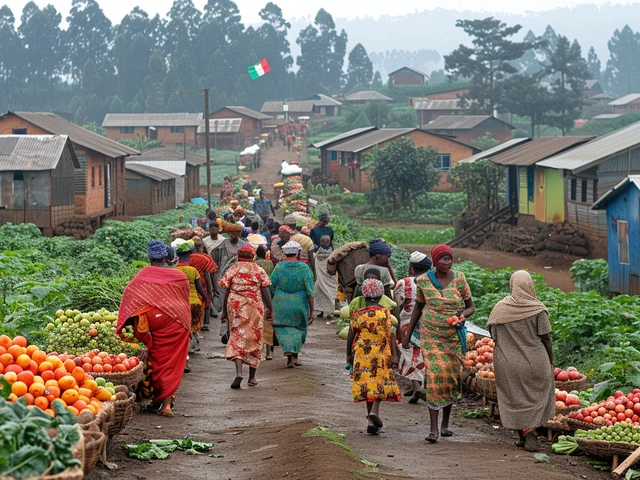Situated in the Horn of Africa, Ethiopia is a country filled with rich history and cultural diversity. However, it is also plagued by various health issues that affect millions of its citizens. Understanding these health concerns is crucial for forming policies and taking action to improve the nation's overall well-being.
Infectious diseases remain a leading cause of illness and death in Ethiopia. Conditions such as malaria, tuberculosis, and HIV/AIDS are rampant due to various factors including climate, hygiene practices, and poor living conditions. These diseases require constant vigilance and comprehensive healthcare strategies to manage and prevent outbreaks.
- Overview of Health Challenges
- Infectious Diseases
- Nutritional Deficiencies
- Maternal and Child Health
- Access to Healthcare
- Steps Towards Improvement
Overview of Health Challenges
The health challenges in Ethiopia are vast and complex, shaped by a mosaic of socio-economic factors, environmental conditions, and healthcare infrastructure limitations. Addressing these challenges requires a comprehensive understanding of the various determinants that influence the health of the population.
One of the most pressing health concerns is the prevalence of infectious diseases. Malaria remains endemic in several regions, leading to high morbidity and mortality rates, especially during the rainy seasons when mosquito populations surge. HIV/AIDS also continues to be a significant threat, despite efforts to increase awareness and improve access to antiretroviral therapy. Tuberculosis, often exacerbated by the HIV epidemic, poses another critical challenge, affecting thousands of individuals each year.
Nutritional deficiencies represent another major issue, with widespread implications for the health of Ethiopia's children. Many suffer from stunted growth due to chronic malnutrition, impacting their cognitive development and general well-being. According to UNICEF, approximately 37% of children under five are stunted, with rates varying significantly across different regions.
Moreover, maternal and child health issues are still prominent. High maternal mortality rates are often linked to limited access to skilled birth attendants and essential obstetric care, particularly in rural areas. Childbirth complications, preventable with proper medical intervention, remain a leading cause of death among women of reproductive age.
Lack of access to healthcare facilities and professionals exacerbates these problems. With fewer healthcare centers in rural areas and a shortage of trained medical personnel, many Ethiopians struggle to receive timely and appropriate care. This limitation is evident in the disparities between urban and rural healthcare services, reflecting the need for more equitable healthcare distribution.
| Health Issue | Prevalence (%) |
|---|---|
| Stunted Growth in Children | 37% |
| HIV/AIDS Prevalence | 1.1% |
| Maternal Mortality Rate | 412 per 100,000 live births |
The multi-faceted nature of these health challenges requires coordinated efforts from various sectors, including government, non-governmental organizations, and international partners. One initiative worth noting is the Health Extension Program, which aims to provide primary healthcare services to rural areas through trained community health workers. This program has shown promise in increasing vaccination rates, improving maternal health, and raising awareness about hygiene and sanitation practices.
Tedros Adhanom, former Minister of Health for Ethiopia, once remarked, "The health of a population is not just an indication of their well-being, but a foundation for economic development and social progress."
Addressing these health challenges is not merely a medical endeavor but a social one. Efforts must include improving education, enhancing economic opportunities, and providing clean water and sanitation to create lasting change. With ongoing dedication and a multifaceted approach, it is possible to make significant strides in overcoming the health issues that Ethiopia faces today.
Infectious Diseases
In Ethiopia, the fight against infectious diseases is a relentless battle that keeps health workers and communities on their toes. Diseases such as malaria, tuberculosis, and HIV/AIDS are not just health issues but are deeply intertwined with the socio-economic fabric of the country. Malaria, for instance, is one of the most prevalent diseases, affecting millions each year. The country's varied climate, ranging from the humid lowlands to cooler highlands, provides the perfect breeding grounds for the Anopheles mosquitoes, which are the primary carriers of the malaria parasite. Despite numerous efforts, malaria remains a persistent threat.
Tuberculosis (TB) is another major health concern. Ethiopia ranks among the 30 high TB burden countries in the world. The spread of TB is facilitated by crowded living conditions and limited access to medical care. Treatment for TB requires a long-term commitment to medication, which can be a challenge in a country where healthcare resources are stretched thin. TB also has co-infections with HIV, which complicates the treatment and increases the risk of drug-resistant strains.
HIV/AIDS continues to be a significant public health issue as well. Although the prevalence rates have stabilized somewhat due to concerted efforts of the government and international organizations, it still affects hundreds of thousands of people. Access to antiretroviral therapy (ART) has improved, but stigma and discrimination create barriers to testing and treatment. This means that people often seek medical help when the disease is already advanced. According to UNAIDS, there were approximately 690,000 people living with HIV in Ethiopia as of the latest reports. This points to the need for continued focus on awareness, prevention, and treatment programs.
"Addressing HIV/AIDS is about more than just health care; it requires tackling social stigma and educating communities," said Dr. Tedros Adhanom Ghebreyesus, Director-General of the World Health Organization.
The spread of infectious diseases is not confined to these three. Diarrheal diseases, caused by poor sanitation and unsafe drinking water, also take a heavy toll, especially on children. Cholera outbreaks are frequent, particularly during the rainy season when flooding can contaminate water supplies. Likewise, diseases like hepatitis E and measles pose significant threats, particularly in remote areas with limited health infrastructure.
Efforts to combat these infectious diseases are multifaceted. The government, along with various international organizations, has launched numerous campaigns to reduce the burden of disease. This includes mosquito control programs such as the distribution of insecticide-treated bed nets and indoor residual spraying to combat malaria. There is also a significant emphasis on vaccination campaigns to prevent the spread of diseases like measles and hepatitis.
Moreover, improving water quality and sanitation infrastructure plays a critical role in disease prevention. Community health education programs aim to inform the public about hygiene practices and the importance of accessing medical services promptly. Innovations such as the use of mobile health clinics help reach remote populations, ensuring that they receive vaccinations, medical check-ups, and essential treatments on a regular basis.

Nutritional Deficiencies
Ethiopia's nutritional challenges are not only significant but also complex, influencing the lives of millions every day. Malnutrition remains a critical issue, particularly among children and pregnant women. Stunted growth, which affects about 37% of children under five years old, is a glaring indication of chronic malnutrition in the country. This high stunting rate is often attributed to the lack of access to nutritious food, prolonged periods of drought, and socio-economic disparities.
Many regions in Ethiopia face severe food insecurity due to recurring droughts and unstable climatic conditions. These environmental challenges exacerbate the problem, leaving communities with limited access to a variety of healthy foods. The diet of many Ethiopians is heavily reliant on staples like teff, maize, and potatoes, which, while calorie-dense, lack essential vitamins and minerals. This dietary insufficiency leads to deficiencies in vital nutrients like iron, iodine, and vitamin A, among others.
Iron deficiency anemia is particularly prevalent and poses a severe health risk, especially for women of reproductive age. Anemia in pregnant women can result in poor pregnancy outcomes, including increased risk of maternal mortality and low birth weights. Addressing this issue requires not only improved dietary practices but also increased access to iron supplements and fortified foods. A comprehensive approach to tackling anemia could include educating communities about iron-rich foods and integrating nutritional programs into prenatal care.
"Addressing malnutrition in Ethiopia requires a multifaceted approach that includes agricultural innovation, educational initiatives, and robust healthcare services," says Dr. Getachew Hailemariam, a prominent public health expert.
Another significant concern is the deficiency of iodine, known to cause goiter and cognitive impairments. Iodine deficiency is commonly linked to geographical areas where the soil is iodine-deficient. In Ethiopia, salt iodization programs have been implemented to combat this issue, but gaps in distribution and public awareness still pose challenges to the program's success.
The lack of vitamin A is another pressing issue, affecting the vision and immune systems of young children. Vitamin A deficiency can lead to severe visual impairment and increased susceptibility to infections. Solutions like promoting the consumption of vitamin A-rich foods such as sweet potatoes, carrots, and green leafy vegetables, along with vitamin supplementation programs, have shown promise but require continued support and expansion to reach all affected populations.
Efforts to combat nutritional deficiencies in Ethiopia also need to consider the intersection of poverty and food insecurity. Improving agricultural productivity through sustainable farming practices and increasing the availability of diverse crops can provide communities with better access to nutritious foods. Additionally, nutritional education programs can help shift dietary habits towards more balanced and healthy choices.
Addressing Ethiopia's nutritional deficiencies is a complex challenge that requires a collaborative effort from the government, NGOs, international organizations, and the communities themselves. By focusing on both immediate needs like supplementation and long-term solutions like agricultural improvements, Ethiopia can make significant strides toward improving the overall health and well-being of its population.
Maternal and Child Health
Maternal and child health is a critical issue in Ethiopia, reflecting broader challenges in the country's healthcare system. Maternal mortality rates are alarmingly high. One primary reason for this is the lack of access to skilled birth attendants during labor. Many Ethiopian women give birth at home without proper medical support. This increases the risk of complications such as hemorrhage, infections, and hypertensive disorders.
Malnutrition also heavily impacts maternal and child health. Pregnant women with insufficient nutrition are more likely to experience difficulties during pregnancy and childbirth. Similarly, malnourished children are at a higher risk of infections and developmental problems. According to UNICEF, more than one-third of Ethiopian children under the age of five are stunted due to chronic malnutrition.
The issue of child health is equally daunting. Ethiopia has made strides in reducing under-five mortality rates, but the numbers are still high. Common causes of child mortality include diarrhea, pneumonia, and neonatal conditions, all of which can be prevented or managed with proper healthcare. Vaccination coverage has improved, yet it remains uneven across different regions, leaving many children vulnerable to preventable diseases.
Efforts to improve maternal and child health in Ethiopia involve multiple stakeholders, including government bodies, international organizations, and community groups. Programs aim to increase the availability and quality of maternal health services, enhance nutritional support, and ensure widespread vaccination coverage. Training health workers and improving healthcare infrastructure are essential to these efforts.
“Access to skilled health services during childbirth can reduce the risk of maternal and newborn deaths by about 75%,” reports the World Health Organization. This stunning figure underscores the importance of bolstering healthcare systems to support mothers and children effectively.
Education also plays a vital role in improving maternal and child health. Informing mothers about the importance of prenatal care, proper nutrition, and recognizing signs of complications can save lives. Community-based health education programs have been successful in raising awareness and encouraging healthy practices among pregnant women and new mothers.
Ethiopia's government has launched several initiatives to tackle these pressing issues. The Health Extension Program, for instance, aims to provide basic health services to rural communities, where the majority of the population resides. By training health extension workers, the program brings essential healthcare closer to those who need it most.
While progress is being made, much work remains to ensure that every mother and child in Ethiopia has access to the healthcare they need. Addressing disparities between urban and rural areas, improving healthcare infrastructure, and investing in education are crucial steps towards better outcomes.

Access to Healthcare
Access to adequate healthcare services is a significant challenge in Ethiopia. The country has a population of over 110 million people, but medical infrastructure remains underdeveloped. Many rural areas are plagued by a shortage of healthcare facilities, trained medical professionals, and essential medicines. This limited access often means that people can go for years without receiving basic medical care.
One of the primary issues is the discrepancy between urban and rural healthcare services. In cities like Addis Ababa, there are relatively more hospitals and clinics. However, in rural regions, people have to travel long distances to the nearest healthcare facility. In some cases, this can be over 100 kilometers. The travel itself can be arduous, and the cost can be prohibitive.
Ethiopia has one of the lowest doctors-to-population ratios in the world, with roughly 3 doctors for every 100,000 people. The World Health Organization recommends a minimum of 23 health workers per 10,000 people.
Rural clinics often lack the necessary equipment and supplies to offer necessary care. For instance, maternal health services are severely inadequate. Women frequently give birth at home without skilled birth attendants. This has resulted in high maternal and infant mortality rates. Statistics show that only about 26% of births are attended by skilled health personnel, which is far below the global average of 78%.
Moreover, many healthcare facilities in Ethiopia face a shortage of trained professionals. The country has made strides in increasing the number of medical schools and training programs, but the need far outstrips the supply. Medical professionals trained in Ethiopia often seek employment abroad where pay and working conditions are better, exacerbating the shortage. This 'brain drain' is a critical issue that needs targeted policy solutions.
In an attempt to mitigate these challenges, the Ethiopian government has implemented various programs aimed at improving healthcare access. One such initiative is the Health Extension Program (HEP), which trains healthcare workers to provide essential services at the community level. These workers, known as Health Extension Workers (HEWs), offer services ranging from vaccinations to basic health education about sanitation and nutrition. Research indicates that areas with active HEWs have seen significant improvements in health indicators, including childhood vaccination rates and maternal health outcomes.
Steps Towards Improvement
Tackling the numerous health challenges in Ethiopia requires a multi-faceted approach. Implementing effective strategies involves government intervention, international aid, and local community involvement. Enhancing healthcare infrastructure is a primary step. There is a need for more hospitals, clinics, and mobile health units, especially in rural areas where access to medical facilities is limited. Strengthening the healthcare workforce through training and education is equally crucial. More doctors, nurses, and healthcare workers must be trained to meet the growing demands of the population.
Preventive measures are essential in reducing the spread of infectious diseases. Public health campaigns focusing on hygiene, vaccination, and education about disease prevention can have a significant impact. For instance, providing mosquito nets and promoting their use has shown to drastically decrease malaria cases. Vaccination drives for diseases such as measles and polio have been successful in many parts of Ethiopia but need to be expanded further.
Nutrition plays a vital role in overall health, especially for children. Programs aimed at improving food security and access to clean water can combat malnutrition effectively. Introducing fortified foods and supplements, along with teaching communities about balanced diets, can make a significant difference. Collaborating with international organizations to provide resources and support is also beneficial.
Maternal and child health requires special attention. Efforts to improve maternal health services include training more midwives, providing prenatal care, and ensuring mothers have access to safe childbirth facilities. Reducing child mortality involves vaccinations, proper nutrition, and education for parents about infant care. Reducing maternal and child mortality rates can have a long-term positive impact on the nation's health.
Emphasis on family planning is necessary to control the high birth rates in some regions. Providing education about contraception and access to contraceptive methods can empower families to make informed decisions about spacing and planning children. This not only helps in managing population growth but also improves maternal and child health.
Bringing improvements in healthcare access for remote and underserved communities is critical. Utilizing technology, such as telemedicine, can bridge the gap between patients and medical professionals. Mobile health clinics can travel to remote areas, providing essential healthcare services and medications. Community health workers can be trained to offer basic healthcare and education, serving as a link between the community and larger healthcare facilities.
Cooperation between the government, non-governmental organizations, and the private sector is key to sustainable improvement. Policies that support healthcare funding, education, and infrastructure development must be prioritized. International aid can provide the necessary resources and expertise to strengthen the nation's health system.
"Health is a state of complete physical, mental and social well-being and not merely the absence of disease or infirmity." - World Health Organization

 Average Monthly Salary in Ethiopia: Understanding the Financial Landscape
Average Monthly Salary in Ethiopia: Understanding the Financial Landscape
 Discover Ethiopia's Vibrant Language Landscape for Career Prospects
Discover Ethiopia's Vibrant Language Landscape for Career Prospects
 Quality of Life and Salary Conditions in Ethiopia
Quality of Life and Salary Conditions in Ethiopia
 Understanding Harmful Traditional Practices in Ethiopia: A Career Awareness Guide
Understanding Harmful Traditional Practices in Ethiopia: A Career Awareness Guide
 How Much Capital is Required to Start a Business in Ethiopia
How Much Capital is Required to Start a Business in Ethiopia
Paul KEIL
June 28, 2024 AT 17:34The overview flaunts buzzwords while ignoring granular data. Casual readers get a skewed picture of Ethiopia's health dynamics. Such high‑level gloss fails to inform policy makers.
Horace Wormely
June 30, 2024 AT 00:26The post correctly highlights the prevalence of malaria, tuberculosis, and HIV/AIDS, yet it could benefit from recent prevalence statistics to contextualize progress. Incorporating data from the 2023 WHO report would strengthen the argument about ongoing challenges. Additionally, distinguishing between urban and rural disparities would provide clearer insight. Overall, the article offers a solid foundation for further discussion.
christine mae cotejo
July 1, 2024 AT 08:23The tapestry of Ethiopia's health crisis is woven with threads of suffering, resilience, and untapped potential. From the relentless march of malaria across the lowland valleys to the silent scourge of iron‑deficiency anemia gnawing at the vitality of mothers, the picture is both harrowing and complex. One cannot overlook the staggering statistic that over a third of children under five are stunted, a haunting reminder that nutrition is the cornerstone of national development. The persistence of tuberculosis in densely populated regions underscores the urgent need for robust diagnostic networks and sustained treatment adherence. Meanwhile, HIV/AIDS, despite modest gains in antiretroviral coverage, continues to shadow vulnerable communities with stigma that hampers testing and care. Waterborne diseases such as cholera erupt with alarming regularity during the rainy season, exposing the fragility of sanitation infrastructure. The health extension workers, who brave remote terrains, embody the hope of bringing preventative care to the doorstep of the most isolated families. Yet, their impact is throttled by chronic shortages of medical supplies and insufficient training opportunities. Maternal mortality, still hovering at alarming levels, reflects deep systemic gaps in obstetric services and emergency response. The data reveals a distressing urban‑rural divide, where city clinics boast modern equipment while villages rely on makeshift facilities. Addressing these inequities demands a coordinated strategy that marries government commitment with international support. Agricultural innovation can alleviate nutritional deficiencies by diversifying crops and enriching soil micronutrients. Educational campaigns that demystify disease transmission empower communities to adopt hygienic practices. Investment in mobile health units can bridge the geographical chasm, delivering vaccines and antenatal care to those previously out of reach. Ultimately, the path to health equity hinges on sustained political will, transparent monitoring, et cetera. Only through a concerted, multifaceted effort will Ethiopia transform its health landscape from a portrait of crisis to one of resilience.
Douglas Gnesda
July 2, 2024 AT 13:33Building on the comprehensive overview, targeting the supply chain for essential medicines could reduce treatment gaps for both TB and malaria. Leveraging community health workers to distribute bed nets and iron supplements would operationalize those recommendations.
Abhijit Pimpale
July 3, 2024 AT 21:30The data already shows a 37 % stunting rate; further emphasis on micronutrient fortification is mandatory.
Eric DE FONDAUMIERE
July 5, 2024 AT 05:26Totally agree that fortification matters, annd we should push local milks fortifed with vitamin A and iron to reach the kids quickly.
Pauline Herrin
July 6, 2024 AT 13:23The analysis overly romanticizes aid without addressing systemic corruption.
pradeep kumar
July 7, 2024 AT 21:20Romanticization blinds policymakers to the stark reality of resource misallocation.
love monster
July 9, 2024 AT 05:16While the challenges are daunting, community‑driven initiatives have repeatedly demonstrated that grassroots empowerment can catalyze measurable health improvements. Encouraging local leaders to champion vaccination drives and nutrition education creates sustainable momentum that complements national programs.
Christian Barthelt
July 10, 2024 AT 13:13Despite the optimism, data from recent field surveys indicate that many community initiatives falter without rigorous monitoring and accountability frameworks; enthusiasm alone cannot guarantee success.